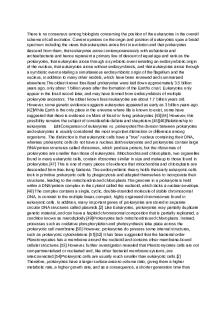N9-digital-sampling - Lecture notes 5 PDF

| Title | N9-digital-sampling - Lecture notes 5 |
|---|---|
| Course | Control systems |
| Institution | University of Salford |
| Pages | 7 |
| File Size | 466.7 KB |
| File Type | |
| Total Downloads | 42 |
| Total Views | 139 |
Summary
Notes on digital sampling....
Description
Part 9 Digital Control - concept and sampling
• Continuous time, discrete time and digital control • Basic structure of a computer-control system – Sampling and A/D conversion – Digital controller – D/A conversion and ZOH
• Sampling and z-Transforms • Control design methods 1
1
Continuous time, discrete time and digital control
r(t)
Continuous controller
y(t) • • • •
r(kT)
Discrete controller
y(kT)
Continuous time (in time and value) Discrete time (dis-continuous in time) Digital control (dis-continuous in both time and values) Difference between latter two is negligible 2
2
1
A basic continuous control system
Continuous Controller u(t)
r(t)
ym(t)
Plant
y(t)
Sensor
3
3
Basic structure of a computer (digital)-control system r(kT)
Digital Controller
D/A
u(t)
y(t) Plant
Clock
ym(kT)
A/D
• A/D: Analogue-to-Digital Converter • D/A: Digital-to-Analogue Converter • Clock: Internal Timer
Sensor ym(t)
4
4
2
Sampling and A/D: A/D
Analogue (voltage) Continuous
Digital signal
T
Analogue(voltage) Discrete
D/A and ZOH: D/A Digital signal
ZOH Analogue (voltage) Continuous
Analogue(voltage) Discrete
5
5
A/D: Sampling process
Analogue (voltage) Continuous
A/D Digital signal
T
Analogue(voltage) Discrete
x(t) x(t)
x(kT)
x(kT)
0
T
2T
3T
time
0
T
2T
3T
time6
6
3
A/D - Sampling rate / sampling frequency
x(t) Variable intervals x(kT) 0
T
2T
time
3T
x(t) Regular intervals, but at a faster rate
x(kT) 0 T 2T 3T
7
time
7
D/A – continuous signal to plant
D/A Digital signal
ZOH Analogue (voltage) Continuous
Analogue(voltage) Discrete
x(kT)
x(t)
0
T
2T
3T
time
8
8
4
Sampled Sequences f(t)
f(kT) 0
time
T 2T 3T
{ f(kT)}= { f (0), f (T ), f (2T ), f (3T ), { f (k )}= { f (0), f (1), f ( 2), f (3),
!}
!}
𝑓𝑘 = 𝑓0, 𝑓1, 𝑓2, 𝑓3, … , 𝑓𝑛, … fk
fn
…eq-1 …eq-2 …eq-3
f (n )
9
9
Sampling from math functions, • in general, replacing t by kT, • T is sampling interval, • k is the sequence (integer numbers = 0, 1, 2, 3….)
f (t ) = 1,
t >0
…eq-1
𝑓𝑘 = 1, 1, 1, … …
f ( t) = t ,
t >0 𝑓𝑘 = 𝑘𝑇
…eq-2
…eq-3 …eq-4
𝑓𝑘 = 0, 𝑇, 2𝑇, 3𝑇 , … …
…eq-5
10
5
Sampling from math functions, • in general, replacing t by kT, • T is sampling interval, • k is the sequence (integer numbers = 0, 1, 2, 3….)
f (t ) = e- 5t
…eq-1
𝑓𝑘 = 𝑒 &'+(
…eq-2
𝑓𝑘 = 1, 𝑒 &'( , 𝑒 &)*( , 𝑒 &)'( , … … 𝑓(𝑡) = sin(3𝑡)
…eq-3
…eq-4
𝑓𝑘 = sin(3𝑘𝑇)
…eq-5
𝑓𝑘 = 0, sin(3𝑇) , sin 6𝑇 , … … .
…eq-6
11
11
Design approaches for digital control systems
Plant
Plant
Controller design In continuous-time
Discrete-time form of the plant rep.
A number of conversion methods Convert to Discrete time
Controller design In discrete time 12
12
6
Practice P9-A 1) Find the sampled sequence of the following continuous signals, when the sampling interval T=0.1 and T=0.5 2) Compare the sequences with different sampling intervals and offer your thought on the differences
𝑓1(𝑡) = sin(2𝜋𝑡) 𝑓2(𝑡) = sin(10𝜋𝑡) 𝑓3(𝑡) = 𝑒 &, 𝑓4(𝑡) = 𝑒 &',
13
13
7...
Similar Free PDFs

5 - Lecture notes 5
- 4 Pages

Chapter 5 - Lecture notes 5
- 15 Pages

Chapter-5 - Lecture notes 5
- 6 Pages

Chapter 5 - Lecture notes 5
- 83 Pages

Tutorial 5 - Lecture notes 5
- 3 Pages

Chapter 5 - Lecture notes 5
- 4 Pages

Imagen 5 - Lecture notes 5
- 1 Pages

Quiz 5 - Lecture notes 5
- 11 Pages

Chapter 5 - Lecture notes 5
- 20 Pages

Chapter 5 - Lecture notes 5
- 4 Pages

Lesson 5 - Lecture notes 5
- 22 Pages

5 Statehood - Lecture notes 5
- 4 Pages

Prokaryotes 5 - Lecture notes 5
- 2 Pages

5. Conduct - Lecture notes 5
- 4 Pages

5. Emotions - Lecture notes 5
- 8 Pages

Tema 5 - Lecture notes 5
- 10 Pages
Popular Institutions
- Tinajero National High School - Annex
- Politeknik Caltex Riau
- Yokohama City University
- SGT University
- University of Al-Qadisiyah
- Divine Word College of Vigan
- Techniek College Rotterdam
- Universidade de Santiago
- Universiti Teknologi MARA Cawangan Johor Kampus Pasir Gudang
- Poltekkes Kemenkes Yogyakarta
- Baguio City National High School
- Colegio san marcos
- preparatoria uno
- Centro de Bachillerato Tecnológico Industrial y de Servicios No. 107
- Dalian Maritime University
- Quang Trung Secondary School
- Colegio Tecnológico en Informática
- Corporación Regional de Educación Superior
- Grupo CEDVA
- Dar Al Uloom University
- Centro de Estudios Preuniversitarios de la Universidad Nacional de Ingeniería
- 上智大学
- Aakash International School, Nuna Majara
- San Felipe Neri Catholic School
- Kang Chiao International School - New Taipei City
- Misamis Occidental National High School
- Institución Educativa Escuela Normal Juan Ladrilleros
- Kolehiyo ng Pantukan
- Batanes State College
- Instituto Continental
- Sekolah Menengah Kejuruan Kesehatan Kaltara (Tarakan)
- Colegio de La Inmaculada Concepcion - Cebu